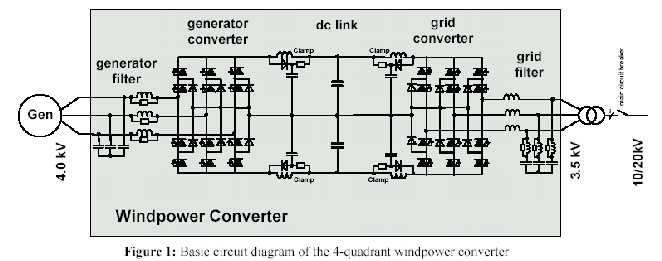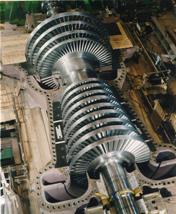6-2-08
The AGV (Alstom) consumes 15% less energy than its main competitors, according to Alstom. The AGV emits 2.2 grams of CO2 per passenger km, 13 times less than a bus (30 grams), 50 times less than a car (115 grams) and 70 times less than a plane (153 grams), based on the rate of CO2 emissions per kWh of electricity produced in France.
Another innovation in the AGV is the use of synchronous permanent magnet motors to provide electro-dynamic traction and braking. When fitted with six drive bogies in an 11-car configuration (360 kph), the AGV generates power of 22.6 kW/ton, 23% higher than its main competitor.Top
Econcern 40% van het bedrijfskapitaal is in handen van de SVH (Fentener van Vlissingen) en Cofra Holding (Brenninkmeijer), aktief op gebied van duurzame energie
Opslag van gecomprimeerde lucht (35 bar)in zoutkoekels of in poreuze zandlagen: de gasturbines voor teruglevering van electriciteit hebben geen compressor nodig!!!!
The extremely large capacities possible from vanadium redox (reduction-oxidation)flow batteries make them well suited to use in large power storage applications such as helping to average out the production of highly variable generation sources such as wind or solar power, or to help generators cope with large surges in demand.
Their extremely rapid response times also make them superbly well suited to UPS type applications, where they can be used to replace Lead-acid batteries and even diesel generators.Top
Flow batteries can be rapidly "recharged" by replacing the electrolyte liquid (in a similar way to refill tank in internal combustion engines) while simultaneously recovering the spent material for re-energization.
Fuel cells are generally defined as electrochemical devices for converting chemical energy to electricity in which the reactants are flowed through a power cell/ reactor from an external source (tank, cylinder or surrounding environment).Top
Under these definitions it may be concluded that the flow battery is a special type of fuel cell. However, what is rarely explicitly stated is that the electrolyte in a fuel cell remains at all times within the reactor (in the form of an ion-exchange membrane, for example). What flows into the reactor are only the electroactive chemicals, which are non-conducting (e.g. hydrogen, methanol, oxygen, etc.) This is in stark contrast to a flow battery in which at least some of the electrolyte (generally the majority in weight and volume terms) flows through the reactor.
Flow batteries are also distinguished from fuel cells by the fact that the chemical reaction involved is often reversible, i.e. they are generally of the secondary battery type and so they can be recharged without replacing the electroactive material. In this sense fuel cells, as sources of electricity, and flow batteries, for storage of electricity, may be seen as complementary in achieving a hydrogen economy.Top
In terms of energy density, existing commercial supercapacitors range around 0.5 to 10 Wh/kg, with the standardized cells available from Maxwell Technologies rated at 6 Wh/kg. Experimental supercapacitors from the MIT LEES project have demonstrated densities of 30 Wh/kg and appear to be scalable to 60 Wh/kg in the short term, while EEStor claims their examples will offer capacities on the order of 200 to 300 Wh/kg. For comparison, a conventional lead-acid battery is typically 30 to 40 Wh/kg, modern lithium-ion batteries are about 120 Wh/kg, and in an automobile applications gasoline has a net calorific value of around 12,000 Wh/kg.
Additionally, supercapacitors offer much higher power density than batteries. Power density combines the energy density with the speed that the energy can be drawn out of the device. Batteries, which are based on the movement of charge carriers in a liquid electrolyte, have relatively slow charge and discharge times. Capacitors, on the other hand, can be charged or discharged at a rate that is typically limited by current heating the electrodes. So while existing supercapacitors have energy densities that are perhaps 1/10 th that of a conventional battery, their power density is generally ten to one-hundred times as great.Top
Other advantages of supercapacitors compared with rechargeable batteries are extremely low internal resistance or ESR, high efficiency (up to 97-98%), high output power, extremely low heating levels, and improved safety. According to ITS (Institute of Transportation Studies, Davis, CA) test results, the specific power of supercapacitors can exceed 6 kW/kg at 95% efficiency.
19-1-08 V2G (vehicle to grid)
V2G
Green Car Congress
Top
Windenergie
Zurich, Switzerland (september 1998) Hailing it as an "exponential technological leap," engineers from ABB Industrial Systems have unveiled a new power switching device that reportedly offers fast switching and low power loss. The firm's engineers describe it as simpler, faster, more efficient, and less costly to operate than conventional silicon-based power switching technologies.
Known as the Integrated Gate Commutated Thyristor (IGCT), the new semiconductor technology makes it easy and cost effective to switch up to 10 megawatts of power at medium voltages Designed for ...
A medium voltage converter introduced in 1998 at ABB based on three-level technology and the semiconductor switch IGCT (Integrated Gate Commutated Thyristor). This family of converters (ACS 1000) was available for the power range from 0.5 MVA to 5.5 MVA at voltage levels of 3.3 kV and 4.0 kV. These converters are optimized for drives i.e. optimized to feed electrical motors. For the operation in windturbines it was necessary to extend the operating range from 2-quadrant operation to 4-quadrant operation and also to develop the control algorithms for new types of machines like e.g. permanent magnet excited synchronous generators.

Per motorgondel varieren de vermogens van de generatoren van 2 tot 5 Mw. Meestal gebruikt men synchrone generatoren, maar vaak ook dubbelgevoede asynchrone generatoren. In het laatste geval compenseert men asynchroon toerental van de wieken met de lage variabelefrequentie-voeding van de rotorwikkeling.
Een niet synchrone loop van de molenwieken wordt als maar meer geprefereerd. Dit kan men ook bereiken met een permanente-magneet generator, een gestuurde generator gelijkrichter, DC-link en een PWM wisselrichter naar het net. Zie figuur boven.Top
De powerconversion strategie van een heel windpark..????
Hongyanhe
The Hongyanhe units are to be CPR-1000s, a Chinese standard design evolved from the Areva-supplied pressurized water reactors at Lingao and Daya Bay.
Now it is known that Alstom will supply 1000 MWe-class Arabelle steam turbines for all four units. They will come complete with four-pole turbogenerators, condensers and moisture separator reheaters.

An Arabelle Steam Turbine
Top
5-4-2008
The development, production and sale of both monocrystalline and polycrystalline PV cells, as well as "thin film" modules that can be produced through a similar process to a DVD.
Deregulation is partially to blame. In deregulated markets, utilities are required to share their transmission lines to promote competition. But in this system, they have little financial incentive to maintain and build more lines. Profits increase the longer the equipment is in use, discouraging updates and repairs. In particular, public utilities, who must answer to shareholders, have a difficult time justifying building new lines. After all, the utility is no longer the sole beneficiary of the investment.